Cohen I.M., Kundu P.K. Fluid Mechanics
Подождите немного. Документ загружается.

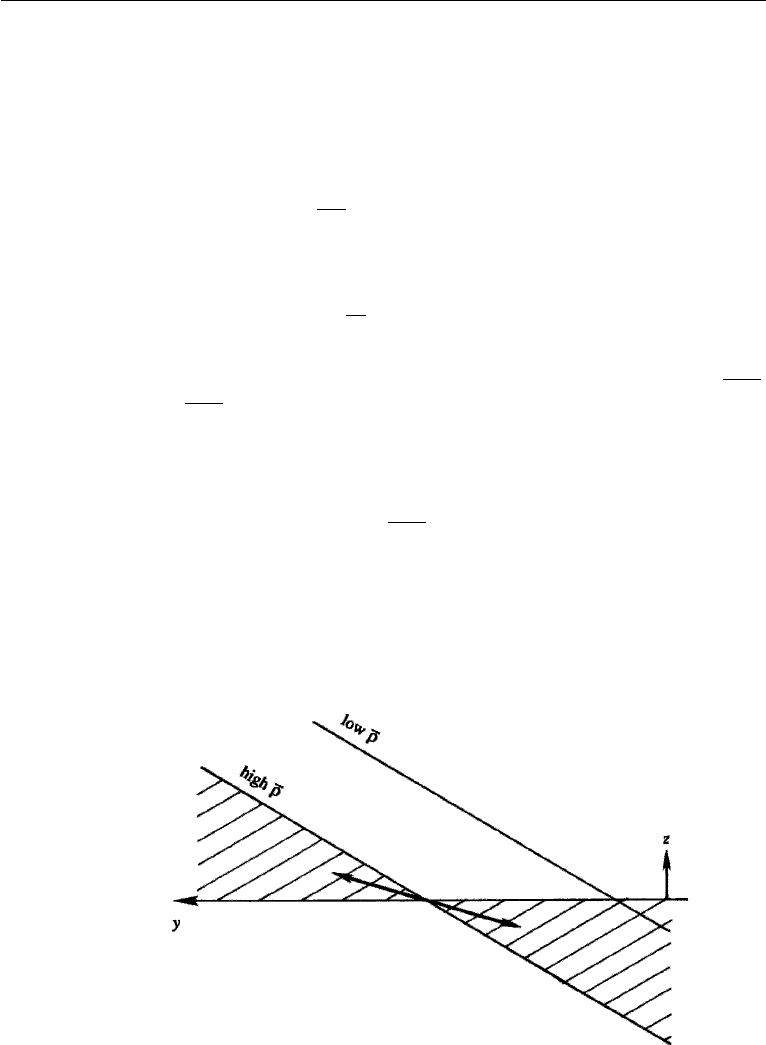
672 Geophysical Fluid Dynamics
multiplying the equations for ∂u
/∂t and ∂v
/∂t by u
and v
, respectively, adding
the two, and integrating over the region of flow. Because of the assumed periodicity
in x and y, the extent of the region of integration is chosen to be one wavelength in
either direction. During this integration, the boundary conditions of zero normal flow
on the walls and periodicity in x and y are used repeatedly. The procedure is similar
to that for the derivation of equation (12.83) and is not repeated here. The result is
dK
dt
=−g
w
ρ
dx dy dz,
where K is the global perturbation kinetic energy
K ≡
ρ
0
2
(u
2
+ v
2
)dxdydz.
In unstable flows we must have dK/dt > 0, which requires that the volume inte-
gral of w
ρ
must be negative. Let us denote the volume average of w
ρ
by w
ρ
.
A negative
w
ρ
means that on the average the lighter fluid rises and the heavier fluid
sinks. By such an interchange the center of gravity of the system, and therefore its
potential energy, is lowered. The interesting point is that this cannot happen in a stably
stratified system with horizontal density surfaces; in that case an exchange of fluid
particles raises the potential energy. Moreover, a basic state with inclined density
surfaces (Figure 14.30) cannot have
w
ρ
< 0 if the particle excursions are vertical.
If, however, the particle excursions fall within the wedge formed by the constant den-
sity lines and the horizontal (Figure 14.32), then an exchange of fluid particles takes
lighter particles upward (and northward) and denser particles downward (and south-
ward). Such an interchange would tend to make the density surfaces more horizontal,
releasing potential energy from the mean density field with a consequent growth of the
Figure 14.32 Wedge of instability (shaded) in a baroclinic instability. The wedge is bounded by constant
density lines and the horizontal. Unstable waves have a particle trajectory that falls within the wedge.

18. Geostrophic Turbulence 673
perturbation energy. This type of convection is called sloping convection. According
to Figure 14.32 the exchange of fluid particles within the wedge of instability results
in a net poleward transport of heat from the tropics, which serves to redistribute the
larger solar heat received by the tropics.
In summary, baroclinic instability draws energy from the potential energy of
the mean density field. The resulting eddy motion has particle trajectories that are
oriented at a small angle with the horizontal, so that the resulting heat transfer has a
poleward component. The preferred scale of the disturbance is the Rossby radius.
18. Geostrophic Turbulence
Two common modes of instability of a large-scale current system were presented in the
preceding sections. When the flow is strong enough, such instabilities can make a flow
chaotic or turbulent. A peculiarity of large-scale turbulence in the atmosphere or the
ocean is that it is essentially two dimensional in nature. The existence of the Coriolis
force, stratification, and small thickness of geophysical media severely restricts the
vertical velocity in large-scale flows, which tend to be quasi-geostrophic, with the
Coriolis force balancing the horizontal pressure gradient to the lowest order. Because
vortex stretching, a key mechanism by which ordinary three-dimensional turbulent
flows transfer energy from large to small scales, is absent in two-dimensional flow,
one expects that the dynamics of geostrophic turbulence are likely to be fundamen-
tally different from that of three-dimensional laboratory-scale turbulence discussed
in Chapter 13. However, we can still call the motion “turbulent” because it is unpre-
dictable and diffusive.
A key result on the subject was discovered by the meteorologist Fjortoft (1953),
and since then Kraichnan, Leith, Batchelor, and others have contributed to various
aspects of the problem. A good discussion is given in Pedlosky (1987), to which the
reader is referred for a fuller treatment. Here, we shall only point out a few important
results.
An important variable in the discussion of two-dimensional turbulence is enstro-
phy, which is the mean square vorticity
ζ
2
. In an isotropic turbulent field we can
define an energy spectrum S(K), a function of the magnitude of the wavenumber
K,as
u
2
=
∞
0
S(K) dK.
It can be shown that the enstrophy spectrum is K
2
S(K), that is,
ζ
2
=
∞
0
K
2
S(K) dK,
which makes sense because vorticity involves the spatial gradient of velocity.
We consider a freely evolving turbulent field in which the shape of the velocity
spectrum changes with time. The large scales are essentially inviscid, so that both

674 Geophysical Fluid Dynamics
energy and enstrophy are nearly conserved:
d
dt
∞
0
S(K) dK = 0, (14.143)
d
dt
∞
0
K
2
S(K) dK = 0, (14.144)
where terms proportional to the molecular viscosity ν have been neglected on
the right-hand sides of the equations. The enstrophy conservation is unique to
two-dimensional turbulence because of the absence of vortex stretching.
Suppose that the energy spectrum initially contains all its energy at wavenumber
K
0
. Nonlinear interactions transfer this energy to other wavenumbers, so that the
sharp spectral peak smears out. For the sake of argument, suppose that all of the
initial energy goes to two neighboring wavenumbers K
1
and K
2
, with K
1
<K
0
<K
2
.
Conservation of energy and enstrophy requires that
S
0
= S
1
+ S
2
,
K
2
0
S
0
= K
2
1
S
1
+ K
2
2
S
2
,
where S
n
is the spectral energy at K
n
. From this we can find the ratios of energy and
enstrophy spectra before and after the transfer:
S
1
S
2
=
K
2
− K
0
K
0
− K
1
K
2
+ K
0
K
1
+ K
0
,
K
2
1
S
1
K
2
2
S
2
=
K
2
1
K
2
2
K
2
2
− K
2
0
K
2
0
− K
2
1
.
(14.145)
As an example, suppose that nonlinear smearing transfers energy to wavenumbers
K
1
= K
0
/2 and K
2
= 2K
0
. Then equations (14.145) show that S
1
/S
2
= 4 and
K
2
1
S
1
/K
2
2
S
2
=
1
4
, so that more energy goes to lower wavenumbers (large scales),
whereas more enstrophy goes to higher wavenumbers (smaller scales). This impor-
tant result on two-dimensional turbulence was derived by Fjortoft (1953). Clearly, the
constraint of enstrophy conservation in two-dimensional turbulence has prevented a
symmetric spreading of the initial energy peak at K
0
.
The unique character of two-dimensional turbulence is evident here. In small-
scale three-dimensional turbulence studied in Chapter 13, the energy goes to smaller
and smaller scales until it is dissipated by viscosity. In geostrophic turbulence, on the
other hand, the energy goes to larger scales, where it is less susceptible to viscous
dissipation. Numerical calculations are indeed in agreement with this behavior, which
shows that the energy-containing eddies grow in size by coalescing. On the other hand,
the vorticity becomes increasingly confined to thin shear layers on the eddy bound-
aries; these shear layers contain very little energy. The backward (or inverse) energy
cascade and forward enstrophy cascade are represented schematically in Figure 14.33.
It is clear that there are two “inertial” regions in the spectrum of a two-dimensional
turbulent flow, namely, the energy cascade region and the enstrophy cascade region.
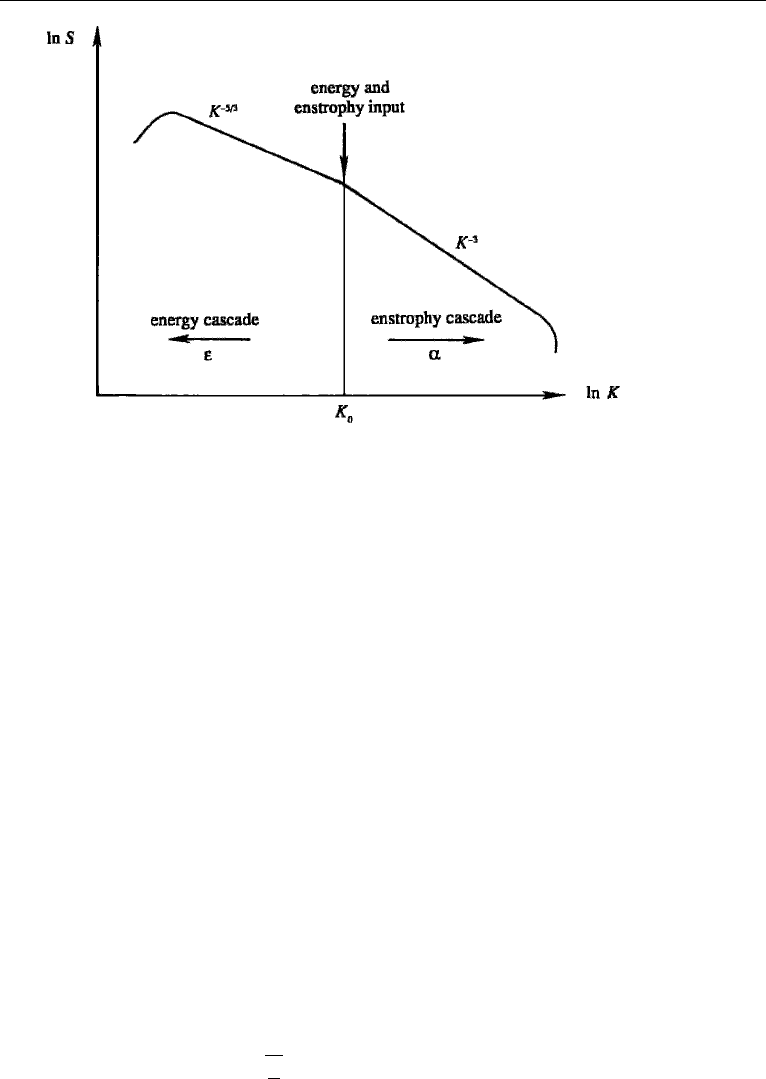
18. Geostrophic Turbulence 675
Figure 14.33 Energy and enstrophy cascade in two-dimensional turbulence.
If energy is injected into the system at a rate ε, then the energy spectrum in the
energy cascade region has the form S(K) ∝ ε
2/3
K
−5/3
; the argument is essentially
the same as in the case of the Kolmogorov spectrum in three-dimensional turbulence
(Chapter 13, Section 9), except that the transfer is backwards.A dimensional argument
also shows that the energy spectrum in the enstrophy cascade region is of the form
S(K) ∝ α
2/3
K
−3
, where α is the forward enstrophy flux to higher wavenumbers.
There is negligible energy flux in the enstrophy cascade region.
As the eddies grow in size, they become increasingly immune to viscous dissipa-
tion, and the inviscid assumption implied in equation (14.143) becomes increasingly
applicable. (This would not be the case in three-dimensional turbulence in which
the eddies continue to decrease in size until viscous effects drain energy out of the
system.) In contrast, the corresponding assumption in the enstrophy conservation
equation (14.144) becomes less and less valid as enstrophy goes to smaller scales,
where viscous dissipation drains enstrophy out of the system. At later stages in the
evolution, then, equation (14.144) may not be a good assumption. However, it can be
shown (see Pedlosky, 1987) that the dissipation of enstrophy actually intensifies the
process of energy transfer to larger scales, so that the red cascade (that is, transfer to
larger scales) of energy is a general result of two-dimensional turbulence.
The eddies, however, do not grow in size indefinitely. They become increasingly
slower as their length scale l increases, while their velocity scale u remains constant.
The slower dynamics makes them increasingly wavelike, and the eddies transform
into Rossby-wave packets as their length scale becomes of order (Rhines, 1975)
l ∼
u
β
(Rhines length),

676 Geophysical Fluid Dynamics
where β = df/dy and u is the rms fluctuating speed. The Rossby-wave propagation
results in an anisotropic elongation of the eddies in the east–west (“zonal”) direction,
while the eddy size in the north–south direction stops growing at
√
u/β. Finally, the
velocity field consists of zonally directed jets whose north–south extent is of order
√
u/β. This has been suggested as an explanation for the existence of zonal jets in
the atmosphere of the planet Jupiter (Williams, 1979). The inverse energy cascade
regime may not occur in the earth’s atmosphere and the ocean at midlatitudes because
the Rhines length (about 1000 km in the atmosphere and 100 km in the ocean) is of
the order of the internal Rossby radius, where the energy is injected by baroclinic
instability. (For the inverse cascade to occur,
√
u/β needs to be larger than the scale
at which energy is injected.)
Eventually, however, the kinetic energy has to be dissipated by molecular effects
at the Kolmogorov microscale η, which is of the order of a few millimeters in the
ocean and the atmosphere. A fair hypothesis is that processes such as internal waves
drain energy out of the mesoscale eddies, and breaking internal waves generate
three-dimensional turbulence that finally cascades energy to molecular scales.
A recent review of intense storm motion (lower atmosphere dynamics and ther-
modynamics) was published by Chan (2005), whereas upper atmospheric motion was
discussed by Haynes (2005). Oceanic flow transport was treated by Wiggins (2005).
Exercises
1. The Gulf Stream flows northward along the east coast of the United States
with a surface current of average magnitude 2 m/s. If the flow is assumed to be in
geostrophic balance, find the average slope of the sea surface across the current at a
latitude of 45
◦
N. [Answer: 2.1 cm per km]
2. A plate containing water (ν = 10
−6
m
2
/s) above it rotates at a rate of 10
revolutions per minute. Find the depth of the Ekman layer, assuming that the flow is
laminar.
3. Assume that the atmospheric Ekman layer over the earth’s surface at a latitude
of 45
◦
N can be approximated by an eddy viscosity of ν
v
= 10 m
2
/s. If the geostrophic
velocity above the Ekman layer is 10 m/s, what is the Ekman transport across isobars?
[Answer: 2203 m
2
/s]
4. Find the axis ratio of a hodograph plot for a semidiurnal tide in the middle
of the ocean at a latitude of 45
◦
N. Assume that the midocean tides are rotational
surface gravity waves of long wavelength and are unaffected by the proximity of
coastal boundaries. If the depth of the ocean is 4 km, find the wavelength, the phase
velocity, and the group velocity. Note, however, that the wavelength is comparable to
the width of the ocean, so that the neglect of coastal boundaries is not very realistic.
5. An internal Kelvin wave on the thermocline of the ocean propagates along
the west coast of Australia. The thermocline has a depth of 50 m and has a nearly
discontinuous density change of 2 kg/m
3
across it. The layer below the thermocline
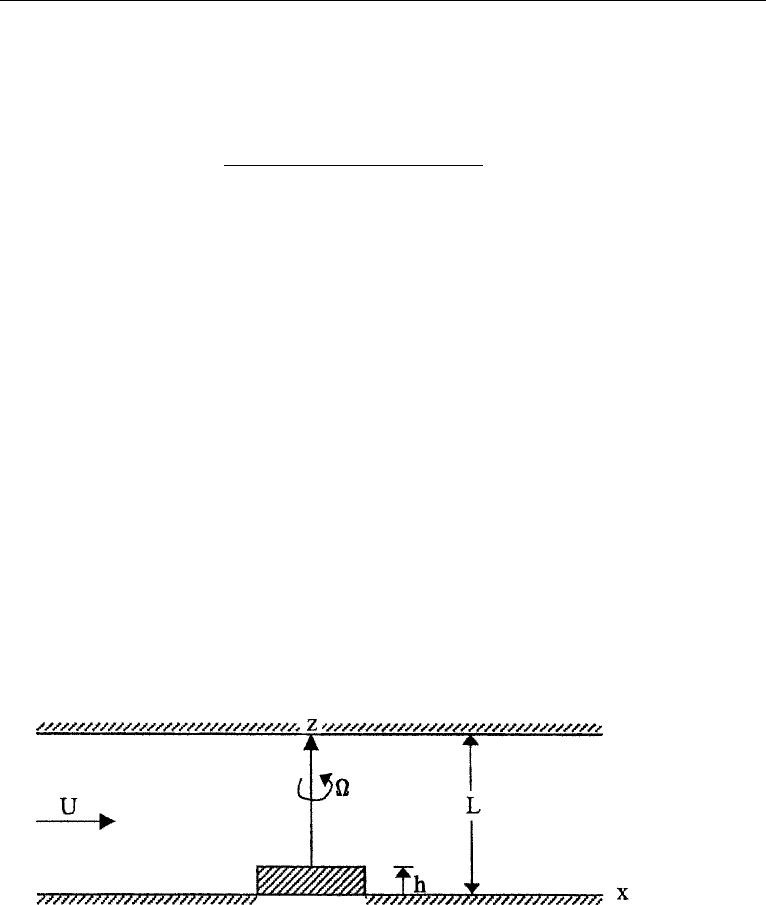
Literature Cited 677
is deep. At a latitude of 30
◦
S, find the direction and magnitude of the propagation
speed and the decay scale perpendicular to the coast.
6. Using the dispersion relation m
2
= k
2
(N
2
− ω
2
)/(ω
2
− f
2
) for internal
waves, show that the group velocity vector is given by
[c
gx
,c
gz
]=
(N
2
− f
2
)km
(m
2
+ k
2
)
3/2
(m
2
f
2
+ k
2
N
2
)
1/2
[m, −k]
[Hint: Differentiate the dispersion relation partially with respect to k and m.] Show
that c
g
and c are perpendicular and have oppositely directed vertical components.
Verify that c
g
is parallel to u.
7. Suppose the atmosphere at a latitude of 45
◦
N is idealized by a uniformly
stratified layer of height 10 km, across which the potential temperature increases by
50
◦
C.
(i) What is the value of the buoyancy frequency N?
(ii) Find the speed of a long gravity wave corresponding to the n = 1 baroclinic
mode.
(iii) For the n = 1 mode, find the westward speed of nondispersive (i. e., very large
wavelength) Rossby waves. [Answer: N = 0.01279 s
−1
; c
1
= 40.71 m/s;
c
x
=−3.12 m/s]
8. Consider a steady flow rotating between plane parallel boundaries a distance
L apart. The angular velocity is and a small rectilinear velocity U is superposed.
There is a protuberance of height h L in the flow. The Ekman and Rossby numbers
are both small: Ro l, E l. Obtain an integral of the relevant equations of motion
that relates the modified pressure and the streamfunction for the motion, and show
that the modified pressure is constant on streamlines.
Literature Cited
Chan, J. C. L. (2005). “The physics of tropical cyclone motion.” Annual Review of Fluid Mechanics 37:
99–128.
Fjortoft, R. (1953). “On the changes in the spectral distributions of kinetic energy for two-dimensional
non-divergent flow.” Tellus 5: 225–230.
Gill, A. E. (1982). Atmosphere–Ocean Dynamics, New York: Academic Press.

678 Geophysical Fluid Dynamics
Haynes, P. (2005). “Stratospheric dynamics.” Annual Review of Fluid Mechanics 37: 263–293.
Holton, J. R. (1979). An Introduction to Dynamic Meteorology, New York: Academic Press.
Houghton, J. T. (1986). The Physics of the Atmosphere, London: Cambridge University Press.
Kamenkovich,V. M. (1967). “On the coefficients of eddy diffusion and eddy viscosity in large-scale oceanic
and atmospheric motions.” Izvestiya, Atmospheric and Oceanic Physics 3: 1326–1333.
Kundu, P. K. (1977). “On the importance of friction in two typical continental waters: Off Oregon and
Spanish Sahara,” in Bottom Turbulence, J. C. J. Nihoul, ed., Amsterdam: Elsevier.
Kuo, H. L. (1949). “Dynamic instability of two-dimensional nondivergent flow in a barotropic atmosphere.”
Journal of Meteorology 6: 105–122.
LeBlond, P. H. and L. A. Mysak (1978). Waves in the Ocean, Amsterdam: Elsevier.
McCreary, J. P. (1985). “Modeling equatorial ocean circulation.” Annual Review of Fluid Mechanics 17:
359–409.
Munk, W. (1981). “Internal waves and small-scale processes,” in Evolution of Physical Oceanography,
B. A. Warren and C. Wunch, eds., Cambridge, MA: MIT Press.
Pedlosky, J. (1971). “Geophysical fluid dynamics,” in Mathematical Problems in the Geophysical Sciences,
W. H. Reid, ed., Providence, Rhode Island: American Mathematical Society.
Pedlosky, J. (1987). Geophysical Fluid Dynamics, New York: Springer-Verlag.
Phillips, O. M. (1977). The Dynamics of the Upper Ocean, London: Cambridge University Press.
Prandtl, L. (1952). Essentials of Fluid Dynamics, New York: Hafner Publ. Co.
Rhines, P. B. (1975). “Waves and turbulence on a β-plane.” Journal of Fluid Mechanics 69: 417–443.
Taylor, G. I. (1915). “Eddy motion in the atmosphere.” Philosophical Transactions of the Royal Society of
London A215: 1–26.
Wiggins, S. (2005). “The dynamical systems approach to Lagrangian transport in oceanic flows.” Annual
Review of Fluid Mechanics 37: 295–328.
Williams, G. P. (1979). “Planetary circulations: 2. The Jovian quasi-geostrophic regime.” Journal of Atmo-
spheric Sciences 36: 932–968.

Chapter 15
Aerodynamics
1. Introduction ..................... 679
2. The Aircraft and Its Controls..... 680
Control Surfaces................. 682
3. Airfoil Geometry ................. 683
4. Forces on an Airfoil .............. 684
5. Kutta Condition ................. 684
Historical Notes ................. 686
6. Generation of Circulation ........ 687
7. Conformal Transformation for
Generating Airfoil Shape ......... 688
Transformation of a Circle into
a Straight Line ............... 689
Transformation of a Circle into
a Circular Arc ................ 689
Transformation of a Circle into
a Symmetric Airfoil........... 691
Transformation of a Circle into
a Cambered Airfoil ........... 691
8. Lift of Zhukhovsky Airfoil ........ 692
9. Wing of Finite Span............. 695
10. Lifting Line Theory of Prandtl
and Lanchester ................. 697
Bound and Trailing Vortices..... 697
Downwash ..................... 698
Induced Drag................... 700
Lanchester versus Prandtl ...... 700
11. Results for Elliptic Circulation
Distribution .................... 701
12. Lift and Drag Characteristics of
Airfoils ......................... 704
13. Propulsive Mechanisms of Fish
and Birds...................... 706
Locomotion of Fish ............. 706
Flight of Birds and insects ...... 707
14. Sailing against the Wind ........ 708
Exercises ....................... 709
Literature Cited ................ 711
Supplemental Reading .......... 711
1. Introduction
Aerodynamics is the branch of fluid mechanics that deals with the determination
of the flow past bodies of aeronautical interest. Gravity forces are neglected, and
viscosity is regarded as small so that the viscous forces are confined to thin boundary
layers (Figure 10.1). The subject is called incompressible aerodynamics if the flow
speeds are low enough (Mach number < 0.3) for the compressibility effects to be
negligible. At larger Mach numbers the subject is normally called gas dynamics,
which deals with flows in which compressibility effects are important. In this chapter
we shall study some elementary aspects of incompressible flow around aircraft wing
shapes. The blades of turbomachines (such as turbines and compressors) have the
same cross section as that of an aircraft wing, so that much of our discussion will also
apply to the flow around the blades of a turbomachine.
679
©2010 Elsevier Inc. All rights reserved.
DOI: 10.1016/B978-0-12-381399-2.50015-0
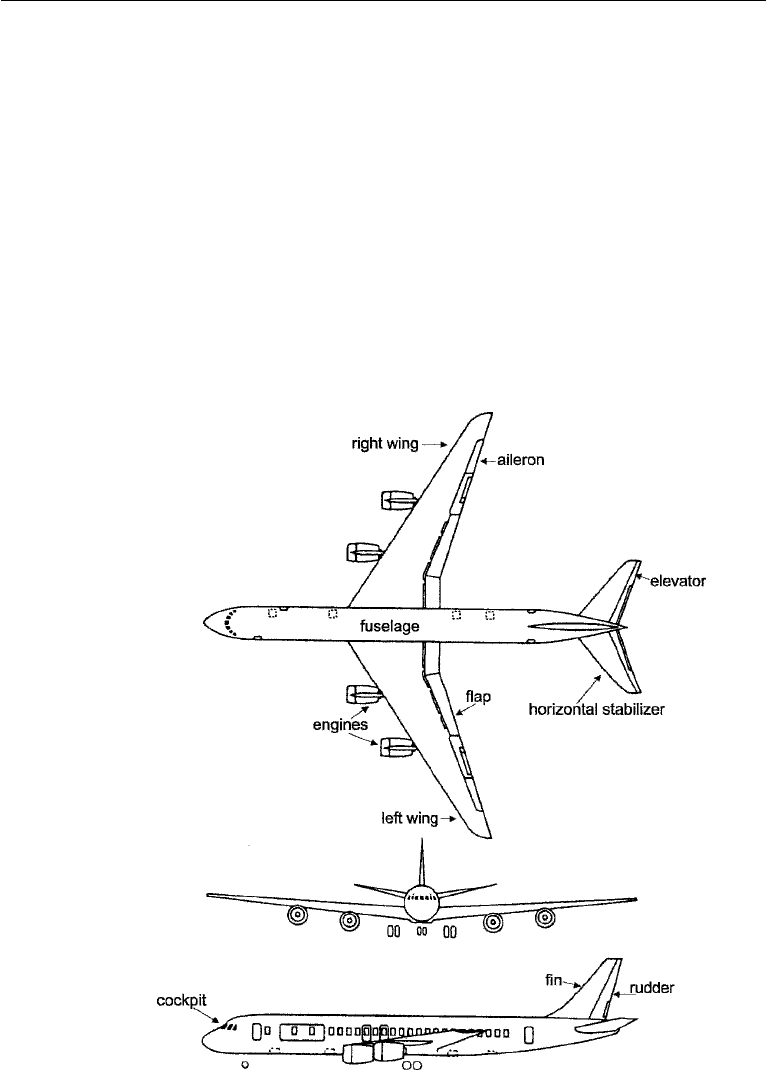
680 Aerodynamics
Because the viscous effects are confined to thin boundary layers, the bulk of the
flow is still irrotational. Consequently, a large part of our discussion of irrotational
flows presented in Chapter 6 is relevant here. It is assumed that the reader is familiar
with that chapter.
2. The Aircraft and Its Controls
Although a book on fluid mechanics is not the proper place for describing an aircraft
and its controls, we shall do this here in the hope that the reader will find it interesting.
Figure 15.1 shows three views of an aircraft. The body of the aircraft, which houses the
passengers and other payload, is called the fuselage. The engines (jets or propellers)
are often attached to the wings; sometimes they may be mounted on the fuselage.
Figure 15.2 shows the plan view of a wing. The outer end of each wing is called the
wing tip, and the distance between the wing tips is called the wing span s. The distance
between the leading and trailing edges of the wing is called the chord length c, which
Figure 15.1 Three views of a transport aircraft and its control surfaces (NASA).
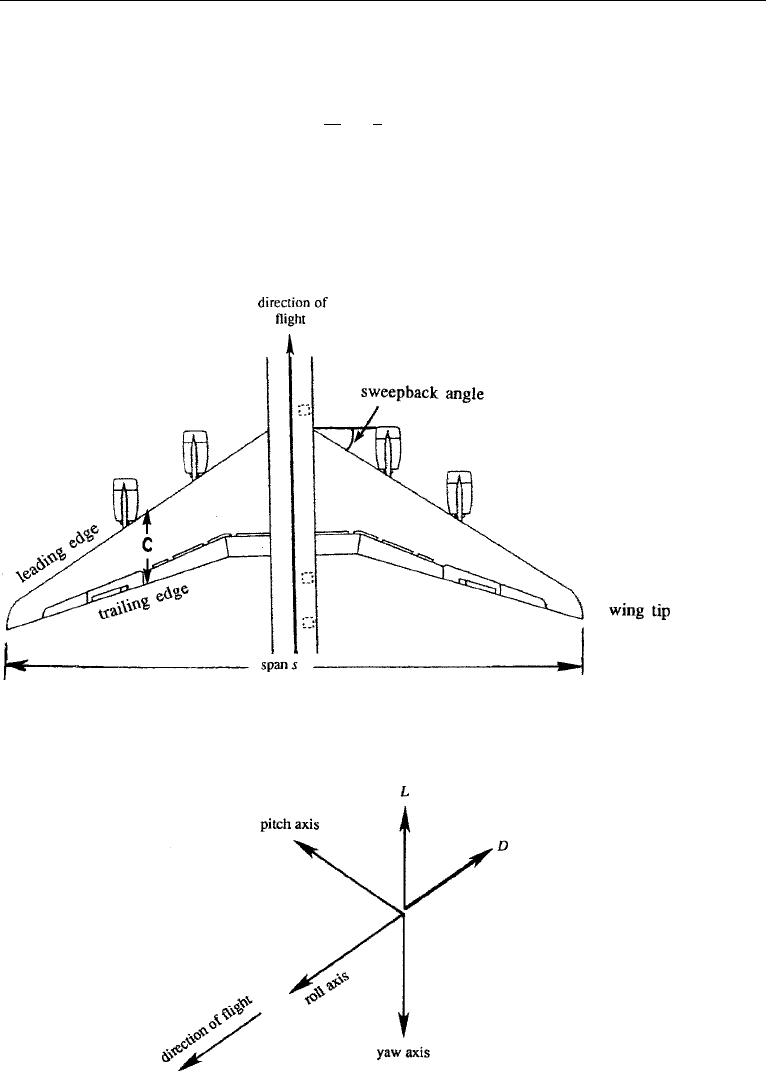
2. The Aircraft and Its Controls 681
varies along the spanwise direction. The plan area of the wing is called the wing
area A. The narrowness of the wing planform is measured by its aspect ratio
≡
s
2
A
=
s
¯c
,
where ¯c is the average chord length.
The various possible rotational motions of an aircraft can be referred to three
axes, called the pitch axis, the roll axis, and the yaw axis (Figure 15.3).
Figure 15.2 Wing planform geometry.
Figure 15.3 Aircraft axes.
